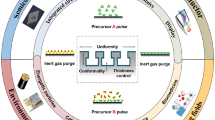Abstract
Despite the discovery of the laser a few decades ago, the potential for pulsed laser deposition (PLD) of thin films has remained unexploited. Despite the sustained pioneering work at Rockwell in laser deposition, it took the development of high-temperature superconductors to fully realize the technique’s potential. Early work on PLD of high-temperature superconductors demonstrated for the first time that the composition of rather complex multi-elementary materials can be reproduced in the deposited film under appropriate conditions of laser energy density and deposition angle. These features made PLD unique; and once the recipe for making in-situ crystalline films of proper stoichiometry was known, the technique’s popularity was significantly enhanced in the research community.
The features of laser deposition that make the process so unique, and that are discussed throughout this issue, are recapped below:
-
1.
Rather complex multi-elementary materials can be deposited well if a single-phase, homogeneous target can be fabricated. The complexity of the deposition process is translated to the relatively easier process of fabricating a high-quality target.
-
2.
The chamber pressure, target-substrate distance, target orientation with respect to the laser beam, etc. are significantly de-coupled, enabling significant freedom in deposition system design. The target is decoupled from the substrate in the sense that a small target can be used to deposit film over a fairly large area substrate with the appropriate scanning schemes.
-
3.
The efficiency of the target use is superior compared to any other technique since a predominant amount of the evaporated material is forward directed and can be collected with a high degree of efficiency. For example, in a production environment, more than 100 YBCO films (ranging 3,000-4,000 Å thick) on 1 × 1 cm2 substrates have been fabricated from a 0.25-inch-thick one-inch target with a majority of the target still left over. The cost of raw materials in a production environment may become significant, and for toxic elements particularly there is a further advantage in minimizing the spread of contaminants.
Similar content being viewed by others
References
J.F. Ready, Effects of High Power Laser Radiation (Academic Press, New York, 1971).
J.P. Cheung and H. Sankur, CRC Critical Reviews, Solid State Materials Sciences, 15 (1988) p. 63.
D. Dijkkamp, T. Venkatesan, X.D. Wu, S.A. Shaheen, N. Jisrawi, Y.H. Min-Lee, W.L. McLean, and M. Croft, Appl. Phys. Lett. 51 (1987) p. 619; X.D. Wu, D. Dijkkamp, S.B. Ogale, A. Inam, E.W. Chase, P.F. Micelli, C.C. Chang, J.M. Tarascon, and T. Venkatesan, Appl. Phys. Lett. 51 (1987) p. 861.
T. Venkatesan, X.D. Wu, A. Inam, and J.B. Wachtman, Appl. Phys. Lett. 52 (1988) p. 1193.
A. Inam, M.S. Hegde, X.D. Wu, T. Venkatesan, P. England, P.F. Miceli, EW Chase, C.C. Chang, J.M. Tarascon, and J.B. Wachtman, Appl. Phys. Lett. 53 (1988) p. 908.
S. Mathews, Neocera, Inc. (College Park, MD). Private communication.
At STI, Inc. (Santa Barbara CA) pulsed laser deposition is used to produce their commercial thallium-based superconducting thin films. The films are produced primarily by a post annealing technique, but from the point of view of preserving stoichiometry and minimizing contamination, the technique has been particularly unique.
Using pulsed laser deposition, a 15-layered integrated SQUID and a flux transformer coil have been successfully fabricated on a single chip at Conductus, Inc. (Sunnyvale, CA).
S. Yilmaz, T. Venkatesan, R. Gerhard-Multhaupt, Appl. Phys. Lett. 58 (1991) p. 2479.
R. Ramesh, K. Luther, B. Wilkens, D.L. Hart, E. Wang, J.M. Tarascon, A. Inam, X.D. Wu, and T. Venkatesan, Appl. Phys. Lett. 57 (1990) p. 1505.
R. Ramesh, A. Inam, B. Wilkens, W.K. Chan, D.L. Hart, K. Luther, and J.M. Parascon, Science 252 (1991) p. 944.
S.R. Foltyn, R.C. Dye, K.C. Ott, K.M. Hubbard, W Hutchinson, R.E. Muenchausen, R.C. Estler, and X.D. Wu, Appl. Phys. Lett. 59 (1991) p. 594.
D. Lowndes, Oak Ridge National Laboratory, Private Communications.
R. Edwards, Neocera, Inc. (College Park, MD). Private communication.
X.D. Wu, R.E. Muenchausen, S. Foltyn, R.C. Estler, C. Flamme, N. Nogar, A.R. Garcia, J. Martin, and J. Tesmer, Appl. Phys. Lett. 56 (1990) p. 1481.
X.D. Wu, R.E. Muenchausen, S. Foltyn, R.C. Estler, R.C. Dye, A.R. Garcia, N. Nogar, P. England, R. Ramesh, D.M. Hwang, T.S. Ravi, C.C. Chang, T. Venkatesan, X.X. Xi, Q. Li, and A. Inam, Appl. Phys. Lett. 57 (1990) p. 523.
J.A. Greer and J.B. Hook, SPIE Proceedings 79 (1990) p. 1377.
R.E. Muenchausen, R.C. Dye, X.D. Wu, L. Luo, and DW Cooke, Appl. Phys. Lett. 59 (1991) p. 1374.
S. Witanachchi, H.S. Kwok, XW Wang, and D.T. Shaw, Appl. Phys. Lett. 53 (1988) p. 234.
R.K. Singh, J. Narayan, A.K. Singh, and J. Krishnaswamy, AppJ. Phys. Lett. 54 (1989) p. 2271.
Q. Li, X.X. Xi, X.D. Wu, A. Inam, S. Vadlamannati, W.L. McLean, T. Venkatesan, R. Ramesh, D.M. Hwang, J.A. Martinez, and L. Nazar, Phys. Rev. Lett. 64 (1990) p. 3086.
D.H. Lowndes, D.P. Norton, and J.D. Budai, Phys. Rev. Lett. 65 (1990) p. 1160.
For example, for a $20,000 difference the laser pulse energy can be increased by 50%, while for a similar price difference the repetition rate can be increased by an order of magnitude. Private communication with Gerard Zaal of Lambda Physik.
M. Kanai, T. Kawai, and S. Kawai, Appl. Phys. Lett. 58 (1991) p. 771.
Surface Processing and Laser Assisted Chemistry, edited by IW Boyd, E. Fogarassy, and M. Stuke (European Mater. Res. Soc. Symp. Proc, Amsterdam and New York, 1990).
Rights and permissions
About this article
Cite this article
Venkatesan, T., Wu, X.D., Muenchausen, R. et al. Pulsed Laser Deposition: Future Directions. MRS Bulletin 17, 54–58 (1992). https://doi.org/10.1557/S0883769400040628
Published:
Issue Date:
DOI: https://doi.org/10.1557/S0883769400040628




